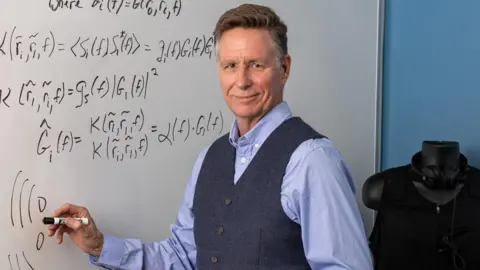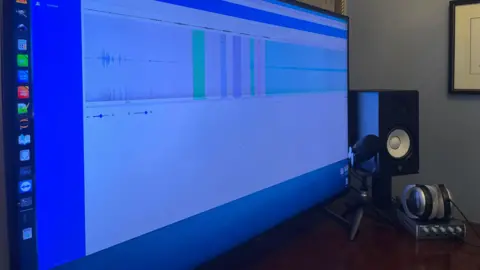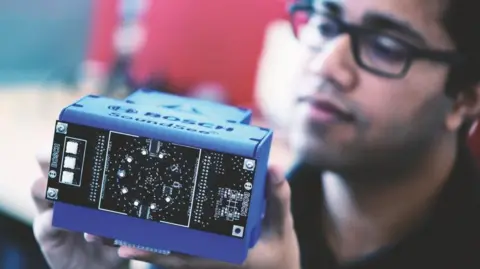Sci-Tech
AI solves the ‘cocktail party problem’ and proves useful in court

 Getty Images
Getty ImagesIt’s the perennial “cocktail party problem” – standing in a room full of people, drink in hand, trying to hear what your fellow guest is saying.
In fact, human beings are remarkably adept at holding a conversation with one person while filtering out competing voices.
However, perhaps surprisingly, it’s a skill that technology has until recently been unable to replicate.
And that matters when it comes to using audio evidence in court cases. Voices in the background can make it hard to be certain who’s speaking and what’s being said, potentially making recordings useless.
Electrical engineer Keith McElveen, founder and chief technology officer of Wave Sciences, became interested in the problem when he was working for the US government on a war crimes case.
“What we were trying to figure out was who ordered the massacre of civilians. Some of the evidence included recordings with a bunch of voices all talking at once – and that’s when I learned what the “cocktail party problem” was,” he says.
“I had been successful in removing noise like automobile sounds or air conditioners or fans from speech, but when I started trying to remove speech from speech, it turned out not only to be a very difficult problem, it was one of the classic hard problems in acoustics.
“Sounds are bouncing round a room, and it is mathematically horrible to solve.”
 Paul Cheney
Paul CheneyThe answer, he says, was to use AI to try to pinpoint and screen out all competing sounds based on where they originally came from in a room.
This doesn’t just mean other people who may be speaking – there’s also a significant amount of interference from the way sounds are reflected around a room, with the target speaker’s voice being heard both directly and indirectly.
In a perfect anechoic chamber – one totally free from echoes – one microphone per speaker would be enough to pick up what everyone was saying; but in a real room, the problem requires a microphone for every reflected sound too.
Mr McElveen founded Wave Sciences in 2009, hoping to develop a technology which could separate overlapping voices. Initially the firm used large numbers of microphones in what’s known as array beamforming.
However, feedback from potential commercial partners was that the system required too many microphones for the cost involved to give good results in many situations – and wouldn’t perform at all in many others.
“The common refrain was that if we could come up with a solution that addressed those concerns, they’d be very interested,” says Mr McElveen.
And, he adds: “We knew there had to be a solution, because you can do it with just two ears.”
The company finally solved the problem after 10 years of internally funded research and filed a patent application in September 2019.
 Keith McElveen
Keith McElveenWhat they had come up with was an AI that can analyse how sound bounces around a room before reaching the microphone or ear.
“We catch the sound as it arrives at each microphone, backtrack to figure out where it came from, and then, in essence, we suppress any sound that couldn’t have come from where the person is sitting,” says Mr McElveen.
The effect is comparable in certain respects to when a camera focusses on one subject and blurs out the foreground and background.
“The results don’t sound crystal clear when you can only use a very noisy recording to learn from, but they’re still stunning.”
The technology had its first real-world forensic use in a US murder case, where the evidence it was able to provide proved central to the convictions.
After two hitmen were arrested for killing a man, the FBI wanted to prove that they’d been hired by a family going through a child custody dispute. The FBI arranged to trick the family into believing that they were being blackmailed for their involvement – and then sat back to see the reaction.
While texts and phone calls were reasonably easy for the FBI to access, in-person meetings in two restaurants were a different matter. But the court authorised the use of Wave Sciences’ algorithm, meaning that the audio went from being inadmissible to a pivotal piece of evidence.
Since then, other government laboratories, including in the UK, have put it through a battery of tests. The company is now marketing the technology to the US military, which has used it to analyse sonar signals.
It could also have applications in hostage negotiations and suicide scenarios, says Mr McElveen, to make sure both sides of a conversation can be heard – not just the negotiator with a megaphone.
Late last year, the company released a software application using its learning algorithm for use by government labs performing audio forensics and acoustic analysis.
 Getty Images
Getty ImagesEventually it aims to introduce tailored versions of its product for use in audio recording kit, voice interfaces for cars, smart speakers, augmented and virtual reality, sonar and hearing aid devices.
So, for example, if you speak to your car or smart speaker it wouldn’t matter if there was a lot of noise going on around you, the device would still be able to make out what you were saying.
AI is already being used in other areas of forensics too, according to forensic educator Terri Armenta of the Forensic Science Academy.
“ML [machine learning] models analyse voice patterns to determine the identity of speakers, a process particularly useful in criminal investigations where voice evidence needs to be authenticated,” she says.
“Additionally, AI tools can detect manipulations or alterations in audio recordings, ensuring the integrity of evidence presented in court.”
And AI has also been making its way into other aspects of audio analysis too.
 Bosch
BoschBosch has a technology called SoundSee, that uses audio signal processing algorithms to analyse, for instance, a motor’s sound to predict a malfunction before it happens.
“Traditional audio signal processing capabilities lack the ability to understand sound the way we humans do,” says Dr Samarjit Das, director of research and technology at Bosch USA.
“Audio AI enables deeper understanding and semantic interpretation of the sound of things around us better than ever before – for example, environmental sounds or sound cues emanating from machines.”
More recent tests of the Wave Sciences algorithm have shown that, even with just two microphones, the technology can perform as well as the human ear – better, when more microphones are added.
And they also revealed something else.
“The math in all our tests shows remarkable similarities with human hearing. There’s little oddities about what our algorithm can do, and how accurately it can do it, that are astonishingly similar to some of the oddities that exist in human hearing,” says McElveen.
“We suspect that the human brain may be using the same math – that in solving the cocktail party problem, we may have stumbled upon what’s really happening in the brain.”
Sci-Tech
Cristiano Ronaldo first to hit 1bn social media followers

Cristiano Ronaldo has hit 1bn total followers across his various social media accounts – making him the first person to reach that mind-boggling figure.
The number is calculated by combining his total number of followers across Instagram, Facebook, Twitter, YouTube, and Chinese social media sites Weibo and Kuaishou.
It does not equate to one billion individual followers, as many people will follow him across multiple platforms, and some will be fake accounts, known as bots.
Nonetheless social media expert Paolo Pescatore, from PP Foresight, described it as a “staggering number” that media and brands would pay close attention to.
“What an achievement, and it further underlines the fundamental shift taking place in media.”
It showed “the power to reach new, younger audiences thanks to technology”, he told the BBC.
On the pitch, Ronaldo was famed for his rivalry with Argentinian star Lionel Messi.
But off it, there is no competition for who is winning the social media contest – Messi has a mere 623 million followers.
Some of the other celebrities with the biggest presence on social media are:
- 690m: Selena Gomez, actor/singer
- 607m: Justin Bieber, singer
- 574m: Taylor Swift, singer
Other notable names the BBC looked into include The Rock (557m), Kylie Jenner (551m ) and Ariana Grande (508m).
MrBeast, the top YouTuber in the world, has 543m total followers, while WWE, often considered to have an enormous social media presence, can only point to reaching a quarter of the audience of Cristiano Ronaldo with 268m combined followers.
The footballer will have reached this milestone thanks to his decision to join YouTube last month, where his channel rocketed to 50 million subscribers within a single week.
So far, the channel consists mainly of conversations between Ronaldo and his wife Georgina Rodríguez, as well as his former Manchester United colleague Rio Ferdinand.
He announced the news in a post shared across his various social media platforms.
Cristiano Ronaldo has made a career out of breaking records.
His successes include being top scorer in Uefa Champions League history, having the most goals in the European Championship, and making more international appearances than anyone else.
Last week he became the first footballer to score 900 top-level career goals.
As with his playing career, he still has scope to improve his numbers on social media too, as unlike some of his rivals, he is not on TikTok or Threads.
All of which is likely to add to another figure he dominates: earnings.
According to Forbes, his total earnings now stand at $260 million – the highest of any athlete.
Sci-Tech
Musk and Zuckerberg have ‘polluted culture’

Meta boss Mark Zuckerberg and X owner Elon Musk are “the worst polluters in human history”, Stephen Fry has said.
The actor and comedian made the claim during a lecture at Kings College, London.
“You and your children cannot breathe the air or swim in the waters of our culture without breathing in the toxic particulates and stinking effluvia that belch and pour unchecked from their companies into the currents of our world,” he said of the pair.
The BBC has approached the two men’s companies for comment.
Mr Fry has a track record of being an early adopter of technology – and was once a regular poster on X, when it was known as Twitter.
He stopped posting in 2022, a few months after the platform was purchased by Mr Musk, but has retained his account. He is no longer active on any social networks.
“I’m the chump who thought social media could change the world,” he told his audience at the Digital Futures Institute.
He said he was at first enthusiastic about the potential of social media to unite people around the world and bring about positive change in society, citing the Arab Spring protests which were coordinated online as an example – but added that he had been proved wrong.
He described what he considered to be a fatal flaw in attempts by early Facebook algorithms to “maximise engagement”, saying nobody had predicted that engagement would be “most maximised by… the worst passions” such as anger, shock and horror.
“We are decidedly hopeless at knowing where technology will take us or what it will do to us,” he said.
He returned to the theme several times throughout his one hour speech, in which he also considered the future of artificial intelligence.
Mr Fry argued that AI was “poised to disrupt every space we have”.
He said he hoped corporate greed would not corrupt the development of AI tech at the expense of safety.
“The best I can do is this – Einstein and Russell said in their manifesto on nuclear weapons – we appeal as human beings to human beings, remember your humanity and forget the rest,” he said.
Mr Fry’s broadside was not the only attack on Mr Musk.
Earlier on Thursday, senior Meta executive Sir Nick Clegg, talking at Chatham House, in London, had been similarly scathing of Mr Musk’s platform X.
The former deputy prime minister called it “a tiny, elite, news-obsessed, politics-obsessed app” and added that in his view the social network had become “a one-man hyper-partisan hobby horse.”
In March 2024 X claimed to have 550 million monthly visitors. Facebook has just over 3bn.
Additional reporting by Liv McMahon
Sci-Tech
Vodafone clashes with UK’s competition watchdog over Three merger

Vodafone and Three have rejected claims by the UK’s competition watchdog that their proposed merger would lead to higher prices for millions of mobile users.
The Competition and Markets Authority (CMA) has “provisionally concluded” the deal would weaken competition between mobile networks.
It has particular concerns that customers who are least able to afford mobile services would be most affected.
The findings are the latest from the CMA’s ongoing probe into the merger, which it launched in January.
The regulator will now consult on its findings and potential solutions to its worries over competition.
These solutions could include legally binding investment commitments, and measures to protect both retail and wholesale customers.
Vodafone’s CEO for European Markets, Ahmed Essam, told the Today programme, on BBC Radio 4, that he still believed the merger would make a better network for customers, and add to the competition in the market.
“We’ve made a significant commitment to an £11bn investment,” he said.
“We’re willing to make sure that this is legally binding, and we undertake a commitment to deploy this.”
He also said the firm had already traded part of its radio spectrum with a competitor.
But the CMA said it is “not convinced” that it would be good for consumers.
“The main knockback to the merging parties is that the CMA considers claims of superior network quality post integration to be “overstated”,” said Kester Mann from analysis firm CCS Insight.
But he said the regulator was not shutting the door on the deal.
“Vodafone and Three should be encouraged by the tone of the CMA’s report, which appears more open to the merger than I was expecting.”
But Rocio Concha, director of policy and advocacy at consumer group Which?, took a different view.
“The regulator’s finding has set a high bar for the merger to proceed,” she said.
“It is clear from those findings that the planned merger between Vodafone and Three could have a negative impact on millions of consumers.”
But she warned it would be “challenging” for the regulator to find remedies for its concerns.
Vodafone and Three revealed plans to merge their UK-based operations in June last year, creating the biggest mobile network in the UK with around 27 million customers.
But the CMA provisionally concluded on Wednesday that such a deal would lead to a “substantial lessening in competition”.
In addition to worries over price and service levels, the regulator is also concerned that the deal may make it more difficult for smaller players such as Lyca Mobile, Sky Mobile and Lebara – who rent space from the bigger operators – to get a good deal.
Vodafone and Three have said the tie-up would lead to an additional investment of £11bn in the UK.
The CMA found that a merger of the two could improve the quality of mobile networks and accelerate next generation 5G networks and services, as claimed by the companies.
But it considered these claims were “overstated”, and that the merged firm would not necessarily have the incentive to carry out planned investment after the merger.
In a statement, Vodafone and Three said they disagreed with the CMA’s findings.
“By all measures, the merger is pro-growth, pro-customer and pro-competition. It can, and should, be approved by the CMA,” they said.
The CMA will issue a final report into the deal in December.
The firms added they would be working with the regulator to secure approval for the tie-up.
-

 African History5 years ago
African History5 years agoA Closer Look: Afro-Mexicans 🇲🇽
-

 African History8 months ago
African History8 months agoBlack History Facts I had to Learn on My Own pt.6 📜
-

 African History5 years ago
African History5 years agoA Closer Look: Afro-Mexicans 🇲🇽
-

 African History1 year ago
African History1 year agoMajor African Tribes taken away during the Atlantic Slave Trade🌍 #slavetrade #africanamericanhistory
-

 African History2 years ago
African History2 years agoCameroon 🇨🇲 World Cup History (1962-2022) #football #realmadrid #shorts
-

 African History1 year ago
African History1 year agoWhat did Columbus Find in 1493? 🤯🔥🔥 #history #civilization #mesoamerica #africa #kemet
-

 African History8 months ago
African History8 months agoBlack History Inventors: Mary Kenner 🩸
-

 African History1 year ago
African History1 year agoOrigin Of ‘Cameroon’ 🇨🇲😳#africa

























